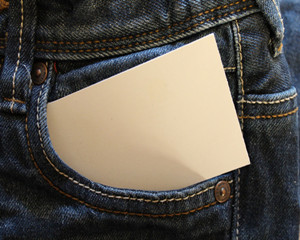Clip-on ties. Fake button holes. Clothing can sometimes be a source of optical illusions. None may be more peculiar than the faux pocket. It’s there when you try on a dress or pair of jeans, try to dig your hand into the pocket, and realize there’s no depth to it. The pocket isn’t there.
夹式领带。假扣眼。有时候,衣服上会有各种假象。但没有比假口袋更奇怪的设计了。当你试穿一条裙子或牛仔裤时,你试着把手伸进“口袋”里,却发现没有口袋。这是一个假口袋。
You’ll see it in women’s clothing, men’s suits, and more. Why do apparel companies do this? Why do some pieces of clothing sport fake pockets when the real thing is so practical?
假口袋会出现在女装和男装中。为什么服装公司要这么设计?真口袋这么实用,为什么要制作有假口袋的衣服呢?
For the garment industry, the reason for a fake pocket is simple. For clothes that sport a specific kind of cut or form, pockets might alter the shape either in the warehouse or on the retail rack. By eliminating pockets in key areas, the apparel is able to maintain its aesthetic profile.
对于服装产业而言,假口袋的存在理由很简单。对于某种特定版型的衣服,口袋可能会让衣服在库房或零售货架上变形。通过移除关键部位的口袋,衣服才能保持外形的美感。
The practice dates back to the 17th century, when pockets were actually removable bags in dresses that women would carry from one ensemble to the next. (This was a wonderful thing for pickpockets, who could simply run off with the entire pocket.) As more streamlined clothing appeared, slim pockets began being sewn into apparel, making a person’s silhouette more aesthetically pleasing for designers.
这一做法要追溯到17世纪,当时裙子上的口袋其实是可拆除的袋子,女性可以将口袋从这件衣服挪到另一件衣服。(这对于扒手来说太棒了,可以拿着袋子直接跑路。)随着流水线服装的出现,瘦小的口袋开始被缝在衣服上,设计师认为这能让一个人的轮廓更具美感。
But after the French Revolution of the 1790s, slim skirts were in, and pockets were out. Bereft of their pocket bags, women turned to handbags instead.
在18世纪90年代法国大革命之后,修身裙流行了起来,口袋被取消了。没有了口袋,女性转而开始使用手提包。
Then designers decided the cut of certain clothing was being disrupted—not only on the rack, but in wearing it. Designers didn’t like the idea of people shoving their hands into their pockets, bunching up the fabric. To discourage any kind of pocket-related distortion, they simply offered pockets that appeared practical but weren’t.
那时候设计师认为特定衣服的版型被口袋破坏了,不光是在货架上,在穿着时也是如此。设计师不喜欢人们把手插进兜里的样子,认为这样会让面料鼓出来。为了阻止衣服因为口袋而变形,设计师干脆设计出看似实用其实无用的假口袋。
So why have pockets at all? For many articles of clothing, especially jeans, people have grown accustomed to seeing pockets as part of the design. It would be odd to see a pair of Levi’s without hand-sized pockets on the hips.
那么,假口袋存在的意义到底是什么?对于许多服装来说,尤其是牛仔裤,人们已经习惯于看到牛仔裤有口袋。如果看到一条李维斯牛仔裤臀部没有口袋会让人感觉很奇怪。

The problem exists primarily with women’s apparel, though men’s suits often fall victim to the practice. You can also blame the fashion industry, which touts dynamic designs emulated by manufacturers. A dress on a runway doesn’t need pockets; by the time a variation of it reaches store shelves, it still doesn’t have any.
假口袋的问题主要存在于女装,不过男装也经常沦为假口袋的牺牲者。你可以责怪标榜创新设计的时装产业,以及跟风模仿的制造商。T台上的裙子不需要口袋,直到仿货在商店上架,原版裙子依然没有口袋。
If you’re flummoxed by the lack of pockets in your clothing, there are workarounds. Some apparel manufacturers use real pockets instead of fakes—they just sew them shut to maintain the clothing’s profile during transport or when people try them on to see if they fit. You can simply snip the threads sewing the pocket shut to make use of them again.
如果你因为衣服没有口袋而手足无措,还是有变通之法的。一些服装制造商会用真口袋而不是假口袋,他们只是把口袋缝上以保持运输中或人们试穿时衣服的版型良好。你可以将缝住口袋的线剪开,这样又可以有口袋可用了。











